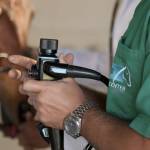“Scoping Stress” Should Not Deter Owners from Gastric Ulcer Diagnostics

Gastroscopy allows veterinarians to directly visualize the surface of the stomach lining. This is the only way that horses can be definitively diagnosed with ulcers, and the only way to reliably assess response to treatment. Some owners are hesitant to “scope” their horses, believing it is too stressful, but recent research should allay these worries.*
Gastric ulcers can develop in either the upper (squamous) or lower (glandular) region of the stomach. And while there is a long list of clinical signs suggestive of gastric ulcers, the only way to know for certain a horse has ulcers is direct visualization using a gastroscope. Further, horses may have either squamous, glandular, or both types of ulcers and the treatment plan for each scenario differs.
“In addition to the financial commitment associated with scoping, some owners are hesitant to proceed with this procedure as they perceive it as too traumatic or worrying to the horse,” said Kathleen Crandell, Ph.D., a Kentucky Equine Research nutritionist.
Looking to assuage owner’s concerns, one veterinary research team measured cortisol levels before and after gastroscopy in 36 client-owned Thoroughbreds at two different time points: at the start of the racing season and again six months later. At each time point, saliva was collected once daily for three consecutive days prior to performing gastroscopy, and again immediately and 30 minutes after gastroscopy. Cortisol, also known as the stress hormone, was measured in each of those saliva samples.
“Salivary cortisol levels increased significantly from baseline compared to the samples taken immediately after gastroscopy. Those cortisol levels decreased by 30 minutes following gastroscopy,” Crandell explained.
According to the research team, stress is not inevitably harmful, and the increase in cortisol levels observed following gastroscopy were in line with those seen in horses following transport or when being confronted with a novel object—activities we frequently expose horses to without pause.
“The cortisol release might not be directly attributable to the gastroscope, because horses were also fasted, muzzled, and sedated for the procedure. Further, the rapid decrease in cortisol after the gastroscope suggests the stress response is short-lived,” explained Crandell.
Horses diagnosed with gastric ulcers by a veterinarian may be prescribed acid-suppressing medications such as omeprazole and potentially other medications depending on the severity and location of the ulcers.
“Supplementing horse’s diets with polyunsaturated fatty acids (PUFAs), particularly eicosapentaenoic acid (EPA), docosahexaenoic acid (DHA), and gamma-linolenic acid (GLA), also shows promise for the management of gastric ulcers,” said Crandell. “After offering ReSolvin EQ, a blend of EPA, DHA, and GLA, to horses with severe ulcer scores (grade 3 to 4) for three months, the prevalence of severe ulcers was lower in supplemented horses compared to untreated horses. Targeted supplementation with ReSolvin EQ is indicated for horses predisposed to gastric ulcers.”
*Ostermeier, S., R. Palme, I. Vervuert, B. Glomm, K. Feige, S. Macho-Maschler, U. König von Borstel, and M. Venner. 2024. Effects of a gastroscopic procedure on salivary cortisol release and fecal cortisol metabolites in young racehorses. Animals (Basel) 14(22):3332.








